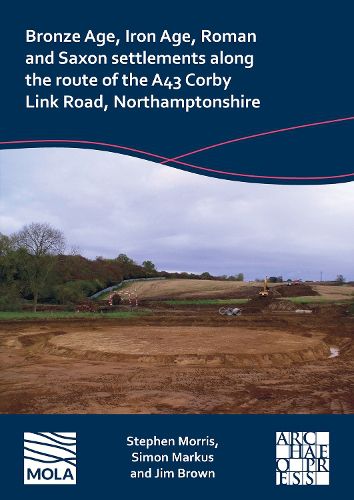Readings Newsletter
Become a Readings Member to make your shopping experience even easier.
Sign in or sign up for free!
You’re not far away from qualifying for FREE standard shipping within Australia
You’ve qualified for FREE standard shipping within Australia
The cart is loading…






MOLA (Museum of London Archaeology) undertook intermittent archaeological mitigation works for the A43 Corby Link Road, Northamptonshire, between June 2012 to October 2013. Early Bronze Age funerary and domestic features/activity were recorded in one location largely on the flood plain on either side of Harper's Brook. Here an undated palaeochannel, a ploughed-out barrow and a dispersed spread of four pits were recovered. Two of the pits had possible placed animal deposits. The barrow was respected by a late Bronze Age cremation. Nearly 2km away there was an isolated early Bronze Age pit contained significant parts of two collard urns. Around 0.8km from the early Bronze barrow was a moderate sized middle Bronze Age flat cremation cemetery. Here there were 30 probable pits of which 25 produced varied quantities of cremated human remains and two other pits retaining pyre deposits. At a different part of the road scheme was a late Bronze Age/early Iron Age pit alignment which was backfilled in the middle Iron Age when a settlement was established. In the early Iron Age, there was a small area comprising postholes and small pits which may denote short term occupation. In the last part of the middle Iron Age in c2nd century BC there were possibly three separate areas of occupation/activity established in different places. This comprised part of a small single-phase (with limited recutting) farmstead which was abandoned by the Conquest period. The second was a very small, segmented enclosure system which was in use for a short period in the 2nd century BC and/ or 1st century BC and the third middle-late Iron Age settlement continued into the early Roman settlement. In two further areas there was a new settlement established in the latest Iron Age or early Roman period and both these were short lived. It was noticeable there was no middle or late Roman settlement remains from any locations within the A43 scheme. Along the valley side to the north of Newton and parallel to a watercourse there was a Saxon settlement of at least hamlet size. This comprised both timber-frame buildings and sunken-featured buildings associated with household industry including a weaving house and iron smelting, the latter occurred within and probably adjacent to the settlement. The evidence of middle Saxon iron smelting is especially rare, and it is within the national important Rockingham Forest ironworking area. The remains of one furnace was found in situ and others suspected nearby, with other iron working related features excavated included roast-ore pits and quarry extraction pits. At another location there was a single Saxon SFB next to Harper's Brook, which was either isolated or had been part of a dispersed settlement.
$9.00 standard shipping within Australia
FREE standard shipping within Australia for orders over $100.00
Express & International shipping calculated at checkout
MOLA (Museum of London Archaeology) undertook intermittent archaeological mitigation works for the A43 Corby Link Road, Northamptonshire, between June 2012 to October 2013. Early Bronze Age funerary and domestic features/activity were recorded in one location largely on the flood plain on either side of Harper's Brook. Here an undated palaeochannel, a ploughed-out barrow and a dispersed spread of four pits were recovered. Two of the pits had possible placed animal deposits. The barrow was respected by a late Bronze Age cremation. Nearly 2km away there was an isolated early Bronze Age pit contained significant parts of two collard urns. Around 0.8km from the early Bronze barrow was a moderate sized middle Bronze Age flat cremation cemetery. Here there were 30 probable pits of which 25 produced varied quantities of cremated human remains and two other pits retaining pyre deposits. At a different part of the road scheme was a late Bronze Age/early Iron Age pit alignment which was backfilled in the middle Iron Age when a settlement was established. In the early Iron Age, there was a small area comprising postholes and small pits which may denote short term occupation. In the last part of the middle Iron Age in c2nd century BC there were possibly three separate areas of occupation/activity established in different places. This comprised part of a small single-phase (with limited recutting) farmstead which was abandoned by the Conquest period. The second was a very small, segmented enclosure system which was in use for a short period in the 2nd century BC and/ or 1st century BC and the third middle-late Iron Age settlement continued into the early Roman settlement. In two further areas there was a new settlement established in the latest Iron Age or early Roman period and both these were short lived. It was noticeable there was no middle or late Roman settlement remains from any locations within the A43 scheme. Along the valley side to the north of Newton and parallel to a watercourse there was a Saxon settlement of at least hamlet size. This comprised both timber-frame buildings and sunken-featured buildings associated with household industry including a weaving house and iron smelting, the latter occurred within and probably adjacent to the settlement. The evidence of middle Saxon iron smelting is especially rare, and it is within the national important Rockingham Forest ironworking area. The remains of one furnace was found in situ and others suspected nearby, with other iron working related features excavated included roast-ore pits and quarry extraction pits. At another location there was a single Saxon SFB next to Harper's Brook, which was either isolated or had been part of a dispersed settlement.